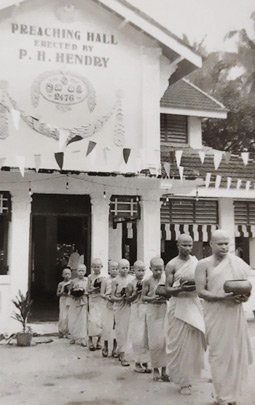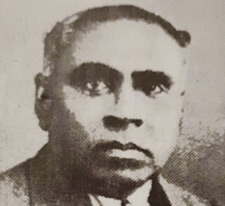
There are many people who arrived in Colombo from rural areas with very little money, subsequently found employment and later went on to be very successful businesspersons.There are many ventures started by such courageous people and it is not at all an exaggeration to say that their innate knowledge and skills brought those businesses to where they are today.
 Not only that they started and developed businesses in Sri Lanka, some of them have started business ventures in other countries too.Some of those business establishments can still be seen in those countries and this article is about the late P. H. Hendry, who became a successful businessman in Malaysia. The story of Hendry begins from the time of his late father, P. H. Dineshami.
Not only that they started and developed businesses in Sri Lanka, some of them have started business ventures in other countries too.Some of those business establishments can still be seen in those countries and this article is about the late P. H. Hendry, who became a successful businessman in Malaysia. The story of Hendry begins from the time of his late father, P. H. Dineshami.
In the 1870s, the port of Galle was full of rocks, making it a dangerous place for inexperienced Seafarers.Due to this, the Seafarers who did not know the location of the Galle harbour did not enter the port instantly, but instead anchored their vessel outside the harbour and fired a shot towards the port to indicate their location.An experienced boatman from the Galle Harbour usually took a small boat and safely navigated those ships to the harbour.Dineshami was the best shipman in Galle at that time and when a vessel reached Galle his service was of very importance.
In addition, he traded with ships and supplied water to the vessels from a place which is now known as the “Watering Point” at the foot of the Ramassala Mountain Range.
He also accompanied his brother, Matheshami to trade in certain ornaments that are made of turtle shells, ebony, and gems. Dineshami’s closest friend, B. P. De Silva went to Singapore and started a jewellery business in 1872.
A sailor who was known to Dineshami also said that Singapore was a good place to open a business and he invited Dineshami to accompany him.
 Accepting the invitation, Dineshami sailed for Singapore in 1875 with a sack full of ebony wood carvings, silverware and gems.Dineshami met a captain while he was on ship-to-ship trade in Singapore where he was invited to go and mine for pearls in Darwin, Australia.Dineshami was interested in what the said captain suggested and he left for Australia. Unexpectedly, however, their ship was caught in a storm and sank.
Accepting the invitation, Dineshami sailed for Singapore in 1875 with a sack full of ebony wood carvings, silverware and gems.Dineshami met a captain while he was on ship-to-ship trade in Singapore where he was invited to go and mine for pearls in Darwin, Australia.Dineshami was interested in what the said captain suggested and he left for Australia. Unexpectedly, however, their ship was caught in a storm and sank.
Fortunately, only Dineshami survived the tragedy and after days of swimming, he reached a beach in Australia, after which he returned to Singapore.
After returning to Singapore, he told Silva what happened during the journey to Australia and was then invited by Silva to join his business.Dineshami, who was not interested in his friend’s suggestion, left for Malaysia and at the time he was fed up with all the small businesses he had initially started.Accordingly, he started a new business, in the form of a bakery.
First bakery
Malaysia was not developed at that time so there was no bread to provide the Europeans.
This is why in 1892 he started the first bakery in Malaysia called the Ceylon Bakery, with two employees brought from Sri Lanka. In time, the bakery became very popular among the Europeans.Around the same time, Dineshhami brought his son Hendry to Malaysia and handed over the bakery to him. While managing this for a while, Henry thought of starting his father’s gem business, along with the jewelry business.
However, when he told his father about his plans, there was a strong objection from Dineshami, since his best friend, Silva was running that business based in Singapore.
When Hendry continued to ask his father about this, Dineshami said that if he wanted to start the business, he should go to meet Silva and obtain permission from him.Accordingly, when Hendry went to Singapore and asked his father’s friend for permission, Silva was very pleased and gave permission to start the business. With the permission of Silva, Hendry came to Malaysia and started his new business in a corner of the bakery located on Malai Street in Kuala Lumpur.That was in 1902. Jewellery and other products were eagerly bought up by the Chinese as well as Europeans and after some time, Hendry bought a three storey building at Batu Road and moved his business to that place.
After the death of Dineshami in 1915, Hendry became the owner of both businesses and they were renamed P.H. Hendry Royal Jeweler.By 1920, Hendry had become the leading businessman in Malaysia, and several royal families in Malaysia chose him as their royal jeweller. The company became the royal jeweller of the Selangor, Kelantan, and Nigeri Sembilan royal families. The Saudi royal family had also been purchasing silverware from this company for some time. Hendry’s company was also the architect of the ivory pairs presented to Queen Elizabeth II of Great Britain by the Malaysian government in 1957, following Malaysia’s independence from the British. Around 1930, a branch of this institution was established on Bishop Road in Penang and had been maintained at a very advanced level.
World War II
However, during World War II in 1944, a bomb exploded near the branch, killing the manager, and Hendry decided to close it.Hendry had also opened a branch in Singapore, which he had been operating until the 1970s.In addition to jewellery, the institute had skilled craftsmen in handicrafts such as ivory carvings.Hendry gifted Emperor Hirohito of Japan a masterpiece of oil painting and he had also owned the Malaysian sales rights to world-renowned brands such as Rolex and Omega.As this business progressed, he turned his attention to another business. Accordingly, he became the owner of several acres of rubber in Malaysia. He had also taken steps to establish a rubber plantation in his hometown of Galle in an area of about 145 acres.
Hendry worked with the Sinhalese who lived in Malaysia to develop the Buddhist temple, now known as Brickfield Maha Vihara, which is the first Buddhist temple in Malaysia. He pioneered the commencement of Vesak celebrations in Malaysia and became the Chairman of the “Sasana Abhivruddhivardhana Society” as well as Chief Contributor of the temple.Sri Lankan bikkhus at that time did not visit Malaysia as it was not a familiar place to them. Therefore, he had worked hard to get monks to come to Malaysia from time to time.
By this time a significant number of Sinhalese lived in Malaysia and together they started the Malaysian Sinhala Association. Hendry, who became the President of the Association in 1939, invited the then Minister of Agriculture D.S. Senanayake and Prof. Gunapala Malalasekera to Malaysia to strengthen the Association. He later opened this association to the Ceylonese Tamil community living in Malaysia. He is also the founder of the first Daham school in Malaysia. He was well received in Malaysia that when the Prince of Wales visited Malaysia in 1921, it was Hendry who welcomed him to Malaysia.At one point, a Malaysian government official had told Hendry that he did not have an office for his duties, and Hendry set aside a part of his own jewellery shop for him.This state official was none other than Tunko Abdul Rahman, who became the first Prime Minister of independent Malaysia.
As a result, the Hendry family still holds a special place in Malaysia. Hendry is still revered by the Malaysian people for his humble demeanour. The Malaysian government has also taken steps to name a street after him and Hendry died on August, 31, 1961 in Galle. After Hendry, the business passed to his son, Grenville Hendry. He was well versed in his father’s business as well as religious and social activities and joined Dr. Kirinde Dhammananda Thera in conducting a major religious service at the Brickfields Temple. He was also awarded the honorary title of DATO by the Government of Malaysia.
After his death, his wife Ranjani Hendry had been running the business and following her recent death, Grenville and Ranjani’s son Suren Hendry now run the business.
